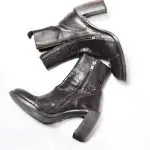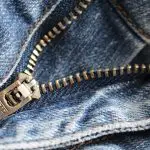You can easily make a no-sew pencil case using colorful fabric tape by cutting sturdy fabric to your desired size and taping the edges to bond the pieces firmly. Choose durable, adhesive fabric tape to guarantee your case holds up well. Attach an 8- to 9-inch zipper by taping it securely along the opening. Add personal touches with patterns or patches, then spot clean as needed. Keep going to discover simple steps for assembly and customization.
Table of Contents
Key Takeaways
- Select strong, durable fabric tape with vibrant colors or patterns to build the pencil case structure without sewing.
- Cut three fabric pieces to size, ensuring extra fabric for seams and using sharp scissors for clean edges.
- Align fabric pieces with right sides together, trim edges evenly, and mark seam lines with a fabric-safe marker.
- Use fabric tape along the edges to bond pieces firmly, assembling step-by-step for precise alignment.
- Personalize with decorative fabric tape patterns, iron-on patches, and maintain by spot cleaning and avoiding direct sunlight.
Materials Needed for Your Fabric Tape Pencil Case
To make your fabric tape pencil case, you’ll need a few essential materials. First, grab fabric tape—choose colorful or patterned rolls to personalize your case.
Start with colorful fabric tape to create a personalized, stylish pencil case with ease.
You’ll also need a sturdy zipper, about 8 to 9 inches long, to secure your items inside. Have a pair of sharp scissors ready to cut the tape and trim fabric neatly. A ruler or measuring tape helps guarantee your pieces are the right size.
You might want a pencil or fabric marker to mark measurements. Finally, prepare a flat workspace to assemble everything smoothly.
These straightforward materials set you up for a quick, no-sew project that’s both functional and stylish. Once you have them, you’re all set to start building your fabric tape pencil case!
Choosing the Right Fabric Tape for Durability and Style
Now that you have all your materials ready, the next step is picking fabric tape that balances durability with style. Choosing the right tape guarantees your pencil case lasts and looks great. Here’s what to take into account:
- Material Strength: Opt for tapes made from polyester or canvas blends. They resist wear and tear better than cotton tapes, keeping your pencil case sturdy.
- Adhesive Quality: Pick tapes with strong, fabric-friendly adhesive. It should hold firmly without peeling off over time or damaging your fabric base.
- Design and Color: Select patterns or solid colors that reflect your personality. Bold prints add flair, while neutral tones offer a classic, versatile look.
Preparing the Fabric Base for Your Pencil Case
Before you start assembling, make certain your fabric base is clean and free of wrinkles. Lay it flat on a smooth surface and use an iron on a low setting if needed to remove any creases. This guarantees a neat look and helps the fabric tape adhere better.
Ensure your fabric is clean and wrinkle-free for a neat finish and better tape adhesion.
Next, measure and cut your fabric to the desired size, allowing extra space for seams. Use sharp scissors for a clean edge, avoiding frayed fabric that can weaken your pencil case.
If your fabric is thin or prone to stretching, consider reinforcing it with a lightweight fusible interfacing. This added support helps maintain shape and durability.
Taking these prep steps will set a solid foundation for your no-sew pencil case project.
Step-by-Step Assembly Using Fabric Tape
First, you’ll cut and prepare the fabric pieces to fit your pencil case design.
Then, you’ll apply fabric tape carefully to join the edges without sewing.
Finally, you’ll assemble the pieces step-by-step to create a sturdy, functional case.
Preparing Fabric Pieces
Gather three fabric pieces cut to your desired pencil case size to start preparing for assembly. Make certain each piece is clean and wrinkle-free for the best results.
Here’s how to get your pieces ready:
- Align the Edges: Place two fabric pieces together with the right sides facing each other. This guarantees the seams will be on the inside once assembled.
- Trim if Needed: Check all edges for evenness and trim any excess fabric to keep everything neat.
- Mark Your Seams: Use a fabric-safe marker to lightly mark where you plan to apply the fabric tape. This step helps guide your assembly and makes the process smoother.
Once your fabric pieces are properly prepped, you’re ready for the next step—applying the fabric tape.
Applying Fabric Tape
With your fabric pieces aligned and edges trimmed, you can start applying the fabric tape to join them.
Peel off the backing carefully and place the tape along the edges where you want to bond the fabric. Press down firmly to guarantee a strong hold. Make sure the tape extends slightly beyond the fabric edges for a secure seal. Work slowly to avoid wrinkles or bubbles.
For corners, cut the tape at a 45-degree angle to create a neat finish. If the tape has a heat-activated adhesive, use a warm iron over parchment paper to set it. Let the tape cool before handling.
Repeat this process for all edges you plan to join, and double-check that everything lines up perfectly before moving on.
Assembling Pencil Case
Although you’ve already prepared your fabric pieces, assembling the pencil case requires careful alignment and firm bonding with fabric tape. Follow these steps to guarantee a neat, durable finish:
- Align the Edges: Place the fabric pieces right sides together, making sure all edges match perfectly.
- Apply Fabric Tape: Starting from one edge, press the fabric tape firmly along the seams. Smooth out any bubbles for a secure hold.
- Seal the Ends: Fold the tape over the ends and press firmly to close the pencil case fully, leaving one side open if you plan to insert a zipper or closure.
Take your time pressing the tape to confirm strong adhesion.
Your no-sew pencil case is now ready for use or further customization!
Adding a Zipper Without Sewing
Since sewing a zipper might seem challenging, you can easily attach one using fabric tape instead.
Start by choosing a zipper that matches your fabric. Lay your pencil case flat and align the zipper along the edge where you want it attached. Use double-sided fabric tape to secure the zipper tape to the fabric, pressing firmly to guarantee it sticks well.
Choose a matching zipper, lay it flat, and secure with double-sided fabric tape for easy attachment.
Fold the fabric tape over the edges of the zipper tape for extra hold. Repeat this on both sides of the zipper. Let the tape set for a few minutes to strengthen the bond.
Finally, test the zipper by sliding it open and closed gently. This no-sew method keeps your pencil case functional without any stitching hassle.
Personalizing Your Pencil Case With Decorative Elements
Now that you’ve attached the zipper without sewing, it’s time to make your pencil case truly yours by adding decorative elements.
Personalizing your creation not only adds flair but also reflects your unique style. Here’s how you can do it:
- Fabric Tape Patterns: Mix and match colorful fabric tapes to create stripes, polka dots, or even geometric shapes.
- Iron-On Patches: Choose patches that resonate with your interests—like stars, animals, or quotes—and stick them on for a fun touch.
- Sticker Embellishments: Use waterproof stickers or fabric glue to add small, detailed designs that pop.
These simple additions transform your pencil case from plain to personalized, making it a fun project and a stylish accessory you’ll love to use every day.
Tips for Maintaining and Cleaning Your No-Sew Pencil Case
When you want your no-sew pencil case to stay looking fresh and last longer, proper maintenance and cleaning are key.
First, avoid overloading it to prevent stretching or damaging the fabric tape. Spot clean any stains immediately using a damp cloth and mild soap—never submerge it fully, as excess water can weaken the adhesive.
Avoid overloading your pencil case and spot clean stains promptly to protect the fabric tape and adhesive.
If you need to freshen the inside, turn the case inside out and gently wipe it down. Let your pencil case air dry completely before using it again.
Store it away from direct sunlight or heat sources to prevent tape discoloration or peeling.
With these simple steps, you’ll keep your no-sew pencil case neat, durable, and ready to hold your supplies for a long time.
Frequently Asked Questions
Can Fabric Tape Pencil Cases Hold Heavy Items Without Tearing?
You shouldn’t rely on fabric tape pencil cases for heavy items since they’re not designed to support much weight. They hold light supplies well, but heavy objects might cause the tape to tear or the case to lose shape.
Is Fabric Tape Safe for Children’s School Supplies?
Imagine your kid’s pencil case staying intact all year—fabric tape is safe for school supplies since it’s non-toxic and durable. Just make sure to choose high-quality, child-friendly tape to avoid any irritation or peeling hazards.
How Long Does a Fabric Tape Pencil Case Typically Last?
A fabric tape pencil case typically lasts several months with regular use. You’ll want to avoid heavy wear and moisture to keep it intact. Over time, the tape might lose adhesion, so occasional repairs help extend its life.
Can I Recycle or Reuse Materials From This Pencil Case?
Sure, you can recycle or reuse materials from your pencil case—unless you prefer hoarding fabric tape rolls like a craft apocalypse survivalist. Just peel off, repurpose, or recycle the fabric tape and fabric scraps responsibly.
Are There Eco-Friendly Fabric Tape Options Available?
You can definitely find eco-friendly fabric tape options made from natural fibers or recycled materials. Look for brands labeled biodegradable or sustainable, so you’ll reduce environmental impact while crafting your projects.
- Chanderi Sarees vs. Banarasi Sarees: What’s the Real Difference? - June 25, 2025
- Is Chanderi Fabric Natural? a Look at Its Eco-Friendly Properties - June 25, 2025
- The Process of Weaving a Chanderi Saree: From Thread to Heirloom - June 25, 2025







